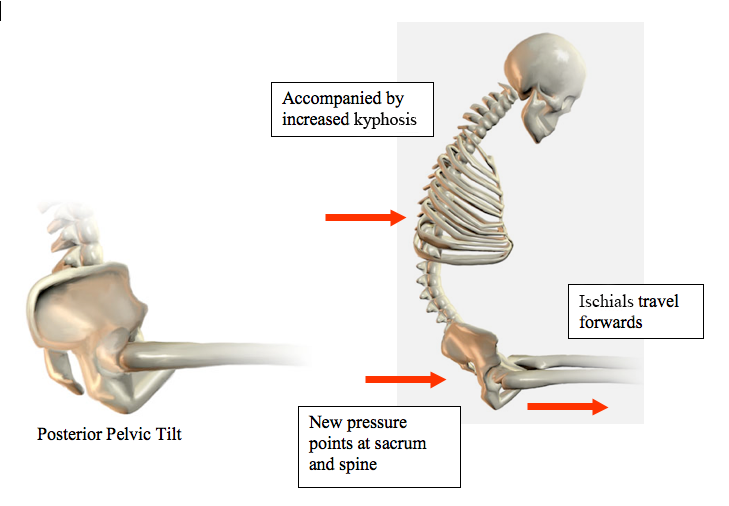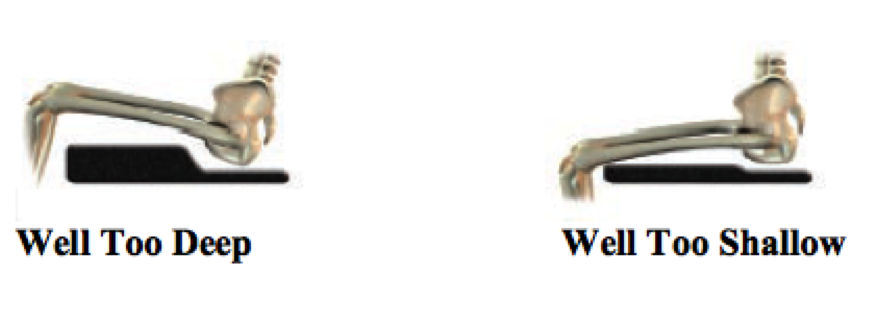Share:
Hello all!
In last month's article, I wrote about cushion considerations for seating a client with a pelvic obliquity. This month, I would like to continue with this practical approach to look at cushion considerations when seating a client with a posterior pelvic tilt.
In an ideal sitting posture, the pelvis is level or has a slight anterior pelvic tilt. With a posterior pelvic tilt, the PSIS are lower than the ASIS. (See the figure below, to the left.) A posterior pelvic tilt is accompanied by an increased kyphosis. In addition, the ischials travel forward and new pressure points are created at the sacrum and the spine. (See the figure below, to the right.)

Some of the clinical issues associated with posterior pelvic tilt are: low or absent tone in the trunk muscles; limited hip flexion; abnormal tone in the trunk and/or lower extremities (e.g. extensor spasticity); pathological reflexes in the lower extremities or trunk; decreased lordosis; tight hamstrings; increased thoracic kyphosis (as shown above); and decreased pelvic/lumbar spine range of motion.
We also have to be aware that sometimes technical issues create the reason for the client presenting with a posterior pelvic tilt. Technical issues include: seat depth being too long; footplates being too high; footplates being too low; the seat-to-floor height being too high for foot propulsion; the hanger angle not accommodating tight hamstrings; no stable base of support (e.g. sling upholstery); back support being too vertical; armrests being too low; and the back not supporting the posterior pelvis.
In completing a hands-on assessment with a client, we can determine whether the presenting posterior pelvic tilt is a fixed or flexible posture. As I have said in previous articles, if the posture is flexible, seating should correct the posture, if the client can tolerate correction. If the posture is fixed, seating must accommodate the posture.
Let's assume we have a client with a flexible posterior pelvic tilt and that the client can tolerate correction. Let's also assume that the presenting posterior pelvic tilt is not caused by any technical factors listed in the above paragraph. What type of cushion works well for a client with this type of flexible posture? A contoured cushion with a posterior well will help to stabilize and position the pelvis into neutral alignment (assuming adequate back support for the posterior pelvis).
There are considerations when selecting a cushion with a posterior well. If the pelvic contour is too long (see the picture below, to the left), the pelvis will not be stabilized and the ischials will slide forward into posterior pelvic tilt. Conversely, if the well is too short (see the picture below, to the right), the ischials will press into the anterior shelf causing potential skin integrity issues.

Another consideration is depth of the anterior well on a cushion. If the well is too deep (see the picture below, to the left), there may be interference with the correct hip angle. In addition, the femurs will not take the load for optimal pressure distribution. Finally, there may be increased pressure at the ischials. If the well is too shallow, which can happen if the overall profile of the cushion is too thin, the femurs will not take the load for optimal pressure distribution. Optimal pressure reduction at the ischials may not be provided as the load is not redistributed away from the ischials. Finally, sliding may be encouraged as the well is insufficient to stabilize the pelvis into position.

As therapists, how will we know that the posterior well of the contoured cushion will be correct for a client with a flexible posterior pelvic tilt? We need to look at the cushion and take it out of its cover to evaluate it. We need to remember that hip width does not equal pelvic size and that it is the pelvic structure that we need to be supporting in the posterior well.
Now, let's assume we have a client with a fixed posterior pelvic tilt with equal hip angles bilaterally. Once again, a contoured cushion with a posterior well will be appropriate for this client, but we must consider the orientation of the pelvis in relation to the well as there could be increased pressure at the ischials at the anterior aspect of the well. For a client with a fixed posterior pelvic tilt, modification to the position of the well may be required (e.g. moving the position of the well 2 inches forward). Now, let's assume that we have a client that presents with a fixed posterior pelvic tilt due to a unilateral hip contracture. In this case, the client's hip angles are unequal and the cushion must accommodate this in order to position the client optimally. Modification to the base of the cushion may be required to modify the hip angle and leg trough to accommodate the unilateral hip contracture.
Please keep in mind that I have talked only about cushion considerations for a client who presents with a posterior pelvic tilt. As with any seating, adequate support at the posterior pelvis must be provided in order for the cushion to perform as intended. In addition, wheelchair configuration must be considered when seating a client with posterior pelvic tilt – a future topic for Clinical Corner!